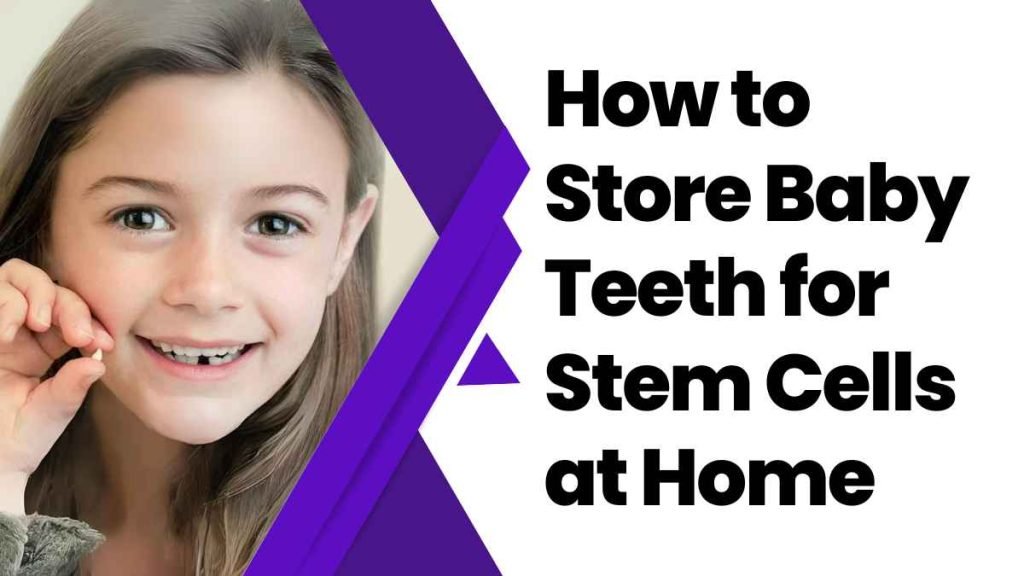How to Store Baby Teeth for Stem Cells at Home! Stem cells have revolutionized medical science, offering promising prospects for treating various diseases. While the umbilical cord has been the primary source of stem cells, baby teeth have emerged as an innovative alternative. In this comprehensive guide, we will explore How to Store Baby Teeth for Stem Cells at Home. Here we will delve into the intriguing world of baby teeth stem cells, exploring what they are, why storing them is essential, and providing a step-by-step guide on how to store baby teeth for stem cells at home.
Table of Contents
Introduction: Decoding the Potential of Baby Teeth Stem Cells
Baby teeth, those tiny treasures left behind by tooth fairies, contain a rich source of stem cells. These cells, scientifically known as dental pulp stem cells (DPSCs), possess the unique ability to differentiate into various cell types, making them invaluable for potential future medical treatments.
What Are Baby Teeth Stem Cells?
Baby teeth stem cells are specialized cells found within the dental pulp of deciduous teeth. Unlike other cells in the body, these stem cells can transform into different cell types, such as bone, nerve, and muscle cells. This versatility makes them a valuable resource for regenerative medicine and potential therapies for diseases like Parkinson’s, diabetes, and spinal cord injuries.

Why Store Baby Teeth for Future Stem Cells?
Storing baby teeth for stem cells preserves a biological insurance policy for your child’s future health. These stem cells have the remarkable ability to regenerate damaged tissues and organs, offering a lifeline in case of future illnesses. By banking baby teeth stem cells, parents secure a personalized medical resource, ensuring access to compatible cells for potential treatments.
How to Store Baby Teeth for Stem Cells at Home: A Step-by-Step Guide
Here you can check the step-by-step guide about How to Store Baby Teeth for Stem Cells at Home:
Total Time: 10 minutes
Choose a Reputable Tooth Bank
Begin by researching trustworthy tooth banks with a proven track record. Ensure the bank complies with industry standards and has a seamless collection and transportation process.
Notify Your Dentist
Inform your child’s dentist about your intention to store their baby teeth for stem cells. The dentist will carefully extract the tooth, preserving its integrity for stem cell retrieval.
Collection and Preservation
After extraction, the dental pulp, housing the stem cells, is carefully stored in a preservation solution. This solution maintains the viability of the cells during transportation to the tooth bank.
Choose Your Storage Plan
Select a storage plan tailored to your preferences. Tooth banks offer various options, including long-term storage plans, ensuring the stem cells remain viable for an extended period.
Choosing the Right Storage Method: Making an Informed Decision
Selecting the right storage method is crucial for ensuring the viability and usability of the stored stem cells. Consider factors such as the tooth bank’s reputation, storage duration, and any additional services offered. Conduct thorough research and consult experts to make an informed decision that aligns with your family’s needs.
Common Mistakes to Avoid: Preserving the Viability of Stem Cells
While the process of storing baby teeth for stem cells is relatively straightforward, there are common mistakes to avoid:
- Delayed Extraction: Ensure timely extraction after the tooth falls out to preserve the stem cells’ vitality.
- Improper Handling: Mishandling the tooth or dental pulp can compromise the stem cells. Follow the dentist’s instructions diligently.
- Choosing Unreliable Tooth Banks: Research extensively and opt for reputable tooth banks to guarantee proper storage conditions.
- Ignoring Expiry Dates: Regularly check storage plans to avoid expiration, ensuring the stem cells remain viable for the desired duration.
Tips and Tricks: Enhancing the Storage Process
Enhance the storage process with these tips and tricks:
- Maintain Proper Dental Hygiene: Encourage good oral hygiene practices to ensure healthy baby teeth, increasing the viability of stem cells.
- Stay Informed: Stay updated on advancements in stem cell research and potential therapies to make informed decisions regarding storage and future treatments.
- Regularly Review Storage Plans: Periodically review your storage plan to confirm its adequacy and explore options for upgrading if necessary.
Facts About Baby Teeth Stem Cells: Unraveling the Mysteries
- Age Relevance: Stem cells from baby teeth are more potent and adaptable than those from adult teeth, making them valuable for medical applications.
- Compatibility: Stored stem cells can potentially be used not only for the child but also for siblings or close relatives, enhancing the family’s overall medical preparedness.
- Non-Controversial Source: Unlike embryonic stem cells, baby teeth stem cells do not raise ethical concerns, making them an ethically viable option for medical research and treatments.
- Regenerative Potential: Baby teeth stem cells have shown promise in regenerating damaged tissues, making them valuable for treating injuries and degenerative diseases.
Conclusion: Embracing the Future of Medical Preparedness
In conclusion of How to Store Baby Teeth for Stem Cells at Home, storing baby teeth for stem cells emerges as a forward-thinking investment. By understanding the potential of baby teeth stem cells, choosing the right storage method, and avoiding common pitfalls, parents can secure a valuable resource for their family’s future well-being. Stay informed, make informed choices, and embrace the future of medical preparedness through the remarkable potential of baby teeth stem cells. Here you can checkout that How to Remove Tetracycline Stains from Teeth.
FAQs About How to Store Baby Teeth for Stem Cells at Home
Is the process of extracting baby teeth for stem cells painful for my child?
No, the extraction process is usually painless, and dentists use methods to ensure minimal discomfort for the child.
Can stored baby teeth stem cells be used for treating diseases in adults?
While the primary focus is on pediatric applications, research is ongoing to explore the potential use of baby teeth stem cells in adult treatments.
What happens if the tooth gets damaged during extraction?
If the tooth gets damaged, the stem cells might be compromised. It’s crucial to choose a skilled dentist experienced in tooth extraction for stem cell storage.
Can stored stem cells be transported to another facility if needed?
Yes, reputable tooth banks have protocols for safe transportation, ensuring the stem cells’ viability during transit.
What is the approximate cost of storing baby teeth stem cells?
The cost varies based on the chosen storage plan and the tooth bank. It’s advisable to compare costs and services before making a decision.
How long can baby teeth stem cells be stored?
With proper storage methods, baby teeth stem cells can be preserved for decades, ensuring their viability for potential future use.
Are there any ongoing research studies related to baby teeth stem cells?
Yes, ongoing research explores various applications of baby teeth stem cells, including regenerative medicine and therapies for neurological disorders, showcasing the continuous advancements in this field.


